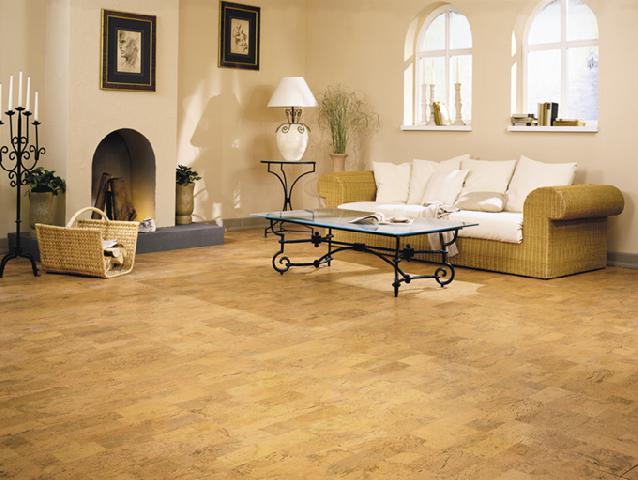Search
Login
Choose a cork floor, focusing on operating conditions, which cork floor is better, how to choose
For a sufficiently long time, cork material was used only for airtight corking of bottles and relatively recently began to be used for the manufacture of cork flooring. In principle, each material has its own advantages and disadvantages, and, of course, there are also positive and negative reviews regarding cork flooring. However, it is possible to draw a correct conclusion about the operational properties of the cork floor; I received complete and reliable information about this material.
Content
- Cork coating material
- Cork elements
- Types of cork coating, their structure and advantages
- The choice of cork
- Cork flooring technology
Cork coating material
A unique material for the manufacture of a new type of flooring is made from cork oak bark.

Interest in cork flooring is far from random, since the material has a whole set of exceptional properties:
- Excellent wear resistance and elasticity;
- Environmentally friendly material;
- Moisture resistance;
- High noise and heat insulation qualities;
- It has an antistatic effect;
- Fire resistance;
- Resists absorption of extraneous odors;
- Biological stability;
- Resists oxidation;
- Light weight.
However, based on the method of processing raw materials into elements suitable for the manufacture of cork products, these properties are improved and even acquire a new meaning.
Cork elements
Agglomerate, veneer and a combination of veneer with agglomerate are the main components of cork flooring, the pros and cons of which affect the finished product.
- Agglomerate is produced under the influence of high temperatures by pressing cork crumbs into blocks, or by rolling to form long strips with subsequent use in floating, adhesive floors;

- The veneer is achieved by cutting from the bark of the tree thin plates necessary to improve the decorative functions of any element (for example, MDF boards);

- The combination of agglomerate with veneer is made by veneer sticker on the obtained agglomerate. It is used in all types of cork flooring.

Despite various methods of converting cork raw materials into partially finished material, its main purpose remains to increase the scope of cork resources.
Types of cork coating, their structure and advantages
Based on the method of installing flooring from a cork, 2 types can be distinguished:
1. Castle cork

This type of coating has a second name - floating floors, since cork boards are not attached to the base, although the constituent elements are firmly bonded to each other. Cork floating coating is a panel with a thickness of 9-12 mm and consists of the following structure:
- The protective layer increases the wear resistance of the coating by applying PVC, varnish;
- The decorative layer consists of veneer, or a combination of veneer with agglomerate;
- The carrier layer is an MDF plate with a lock connection for subsequent installation;
- Lower agglomerate providing heat and noise insulation.

Advantages of floating floors:
- A wide range of colors and textures;
- High strength;
- Excellent wear resistance
- They have anti-slip, antistatic effect;
- High rates of noise, heat insulation;
- Create a comfortable feeling when walking;
- Restoring the original form under mechanical stress;
- Ease of installation;
- Mobility;
- Ease of care.
Disadvantages:
- The impossibility of creating artistic styling, since the presence of locks allows you to lay tiles in only one direction
- The need for a threshold in the doorways to hide the joint seams;
- The possibility of warping due to the low moisture resistance of the floating floor, since the coating has a wooden base, and not cork, like an adhesive floor.
- To replace a damaged panel, you will need to disassemble the entire floor.
Thus, the cork floor of the castle can be stacked in any residential or non-residential premises with a normal level of humidity.
2. Adhesive cork

Floor tiles and panels representing the adhesive floor are produced with a thickness of 3-6 mm. Glue cork floor has the following types of structures:

- A single layer inherent in cork flooring. In this case, first a special impregnation is applied to the front surface of the tile, preventing it from moisture and dirt, and then varnish, which increases the wear resistance of the coating.
- Multilayer, consisting of:
- A protective layer that increases the wear resistance of the coating. In this case, the surface may be matte, transparent, glossy, depending on the coating composition;
- A decorative layer represented by cork veneer or wood veneer. Veneer surface is painted in any color;
- A damping layer including cork agglomerate;
- Adhesive base.

In addition, there are 2 types of adhesive cork tiles:
- Sealed - does not require additional processing, and after laying immediately suitable for use;
- Unpacked after laying needs to be treated with wax, varnish, or oil.
The main advantages of adhesive cork coating include:
- Increased wear resistance, reaching 10-20 years;
- Excellent heat and noise insulation;
- A wide range of colors and textures;
- Antistatic;
- Hygiene
- The thresholds between the rooms are not necessary, since the adhesive tile is laid with a single sheet;
- Moisture resistance;
- The ability to purchase goods without a protective coating;
- Restoring shape after prolonged exposure to the floor with a heavy object;
- Ease of replacing only the damaged area;
- The possibility of styling;
- Easy to care.
Among the disadvantages it is worth highlighting:
- High cost;
- Possible shortage of goods due to limited raw materials;
- Relatively low fracture strength;
- The laying base must be perfectly flat.
Due to the high moisture resistance of adhesive tiles, laying is possible even in relatively high humidity rooms. Based on this, the most preferable option of cork flooring in the kitchen is glutinous. In addition, the service life of the adhesive coating exceeds the castle.
The choice of cork
When choosing any type of cork coating, you should pay attention to the following aspects:
- The tile slice must not have nicks or visible signs of foreign material;
- The wrong side should have a uniform structure;
- To buy cork floors is only known manufacturers. Regarding laminate flooring, cork flooring is significantly higher. In addition, cork material is mined only on the western coast of the Mediterranean, so the production of a quality product is associated with certain difficulties. Trying to avoid scarcity of raw materials and increase profits, unscrupulous manufacturers resort to the addition of cork sawdust, for example, wood sawdust, and give the product a quality cork floor.
Currently, wicanders cork flooring takes a leading place in the Russian market, thanks to which the coating is really made only from cork oak bark and only of high quality.
Cork flooring technology
Laying of the castle and adhesive cork coating is significantly different, and the castle connection of floating floors greatly simplifies the work and reduces time costs. However, not only the final form of the finished coating, but also its service life depends on the correctness and accuracy of the installation.
Before you start laying the coating, you must:
- Level the surface if necessary, although cork can be laid on a wooden, concrete floor or covered with linoleum;
- Maintain the panels during the day in the package, and in the room where the direct installation will take place;
- Place the tiles on the floor and their redistribution to determine the final floor pattern, since each panel has a unique pattern from nature.

installation of the cork floor of the castle
- On the prepared base, with an overlap of 10-20 cm, a plastic film is laid. In order to protect against condensation, the film should go onto the walls, to the height of the baseboard. The joints are sealed with tape.
- If the surface contains small irregularities, then on the film you can lay the insulating back-to-back. The joint is sealed with tape.
- Laying of the coating is done from the right corner of the room so that the panel is located with a comb to the wall. In order to avoid a shift, it is necessary to fix it with spacer wedges (trimmed cork cover). A gap of 5-10 mm is left between the wall and floor tiles.
- The second and subsequent rows are stacked using a lock connection. To do this, the panel of a new row is inserted into the die gap of the previous row at an angle of 30-45 degrees, after which it is carefully lowered to a horizontal position. In this case, the lowering panel must be shifted until it is completely joined with the short edge of the other panel of this row.
- If there are pipes at the bottom of the floor, then, as near the wall, a gap is required in these places.
- In doorways, a threshold is used to join cork panels, which is attached to the floor between the panels.
- At the end of the installation, all expansion wedges are removed.
2-3 days after installation, skirting boards are installed by attaching to the wall, and after a week you can proceed with the arrangement of furniture.

installation of cork floor glue
- The center of the room is marked with a pencil, since the installation of this type of coating comes from the center.
- Perpendiculars are drawn from the center point, orienting the correct laying direction. However, with diagonal laying, the lines are drawn at an angle of 45 degrees.
- Before the process of direct installation, it is necessary to determine the pattern of the finished coating by moving the tiles on the surface.
- Cork flooring is done only with glue recommended by the manufacturer.
- Laying of the coating is carried out by applying glue both on the base of the floor and on the underside of the tile by means of a notched trowel.
- Strongly press the tile to the floor is not necessary. First you need to make sure that the tiles next to each other are correctly joined, and also check that the edges of the panel are on the same level.
- The remaining glue is removed immediately with a solvent.
- After 15-20 minutes, glued tiles need to be tapped with a rubber hammer for better adhesion.
- Near the wall, the tiles are cut with a sharp knife, taking into account a gap of 5 mm.
- Immediately after the installation, the tiles can be freely moved. However, it is better to fix the baseboard to the wall and arrange the furniture in 1-2 days.

If unconsolidated tiles were used as adhesive cork floors, then at the end of laying it is necessary to immediately begin additional processing of the laid surface.
In this case, the application of oil or wax as much as possible preserves all the characteristics of a cork coating. The use of varnish helps to clog the pores of the cork, depriving the coating of some advantages. To apply wax, you must:
- Primer a pre-moistened surface, saturated with natural resins;
- After 15-20 minutes, remove excess resin with a rag;
- After drying, you can apply wax or resin.
- Additional processing significantly increases the useful life of the tile.

Thus, having correctly approached the choice of the necessary cork flooring and having allocated a little time and effort, you can lay the cork floor yourself without the help of specialists, and build not only the original flooring, but also operate it for at least 10-20 years.





